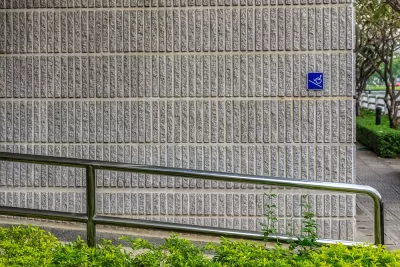A call for the country to focus its infrastructure investments to the most vulnerable and neglected populations—and watch the benefits compound.

Angela Glover Blackwell writes of the "Curb-Cut Effect"—the benefits to the general welfare as an effect of laws and programs designed to benefit vulnerable populations.
The article starts with an anecdote about a guerilla mobility action in Berkeley in the early 1970s, when Michael Pachovas and a few friends "poured cement into the form of a crude ramp" as a political action to support the mobility of the disabled community. The action later became referred to as "the slab of concrete heard 'round the world," paving the way for the adoption of the Americans with Disabilities Act.
The curb cuts required by the ADA, however, precipitated a new era of mobility for the larger population as well. "When the wall of exclusion came down, everybody benefited—not only people in wheelchairs. Parents pushing strollers headed straight for curb cuts. So did workers pushing heavy carts, business travelers wheeling luggage, even runners and skateboarders," writes Glover Blackwell.
From that example from the physical environment Glover Blackwell expands the argument to the demographic realm, noting that "[p]olicymakers tend to overlook the ways in which focusing on one group might help all groups and strengthen the whole nation." More examples and arguments focusing on the physical environment, like bike lanes and bus service, follow later in the article.
FULL STORY: The Curb-Cut Effect

Study: Maui’s Plan to Convert Vacation Rentals to Long-Term Housing Could Cause Nearly $1 Billion Economic Loss
The plan would reduce visitor accommodation by 25,% resulting in 1,900 jobs lost.

Alabama: Trump Terminates Settlements for Black Communities Harmed By Raw Sewage
Trump deemed the landmark civil rights agreement “illegal DEI and environmental justice policy.”

Why Should We Subsidize Public Transportation?
Many public transit agencies face financial stress due to rising costs, declining fare revenue, and declining subsidies. Transit advocates must provide a strong business case for increasing public transit funding.

Paris Bike Boom Leads to Steep Drop in Air Pollution
The French city’s air quality has improved dramatically in the past 20 years, coinciding with a growth in cycling.

Why Housing Costs More to Build in California Than in Texas
Hard costs like labor and materials combined with ‘soft’ costs such as permitting make building in the San Francisco Bay Area almost three times as costly as in Texas cities.

San Diego County Sees a Rise in Urban Coyotes
San Diego County experiences a rise in urban coyotes, as sightings become prevalent throughout its urban neighbourhoods and surrounding areas.
Urban Design for Planners 1: Software Tools
This six-course series explores essential urban design concepts using open source software and equips planners with the tools they need to participate fully in the urban design process.
Planning for Universal Design
Learn the tools for implementing Universal Design in planning regulations.
Smith Gee Studio
Alamo Area Metropolitan Planning Organization
City of Santa Clarita
Institute for Housing and Urban Development Studies (IHS)
City of Grandview
Harvard GSD Executive Education
Toledo-Lucas County Plan Commissions
Salt Lake City
NYU Wagner Graduate School of Public Service





























